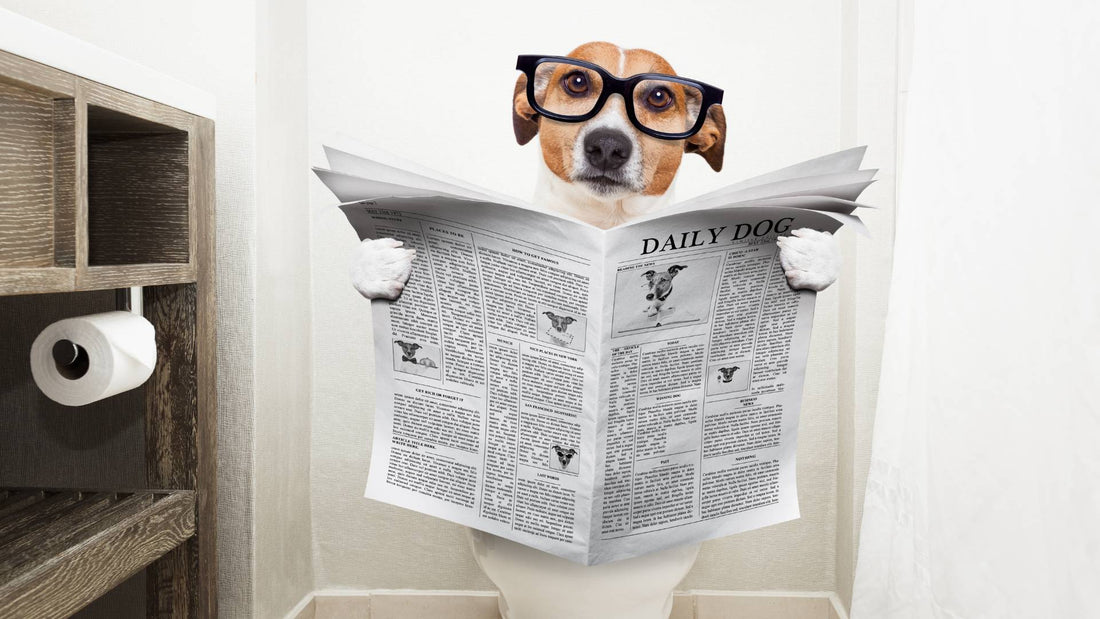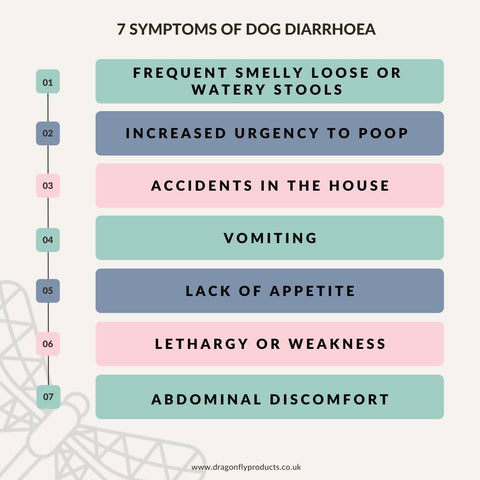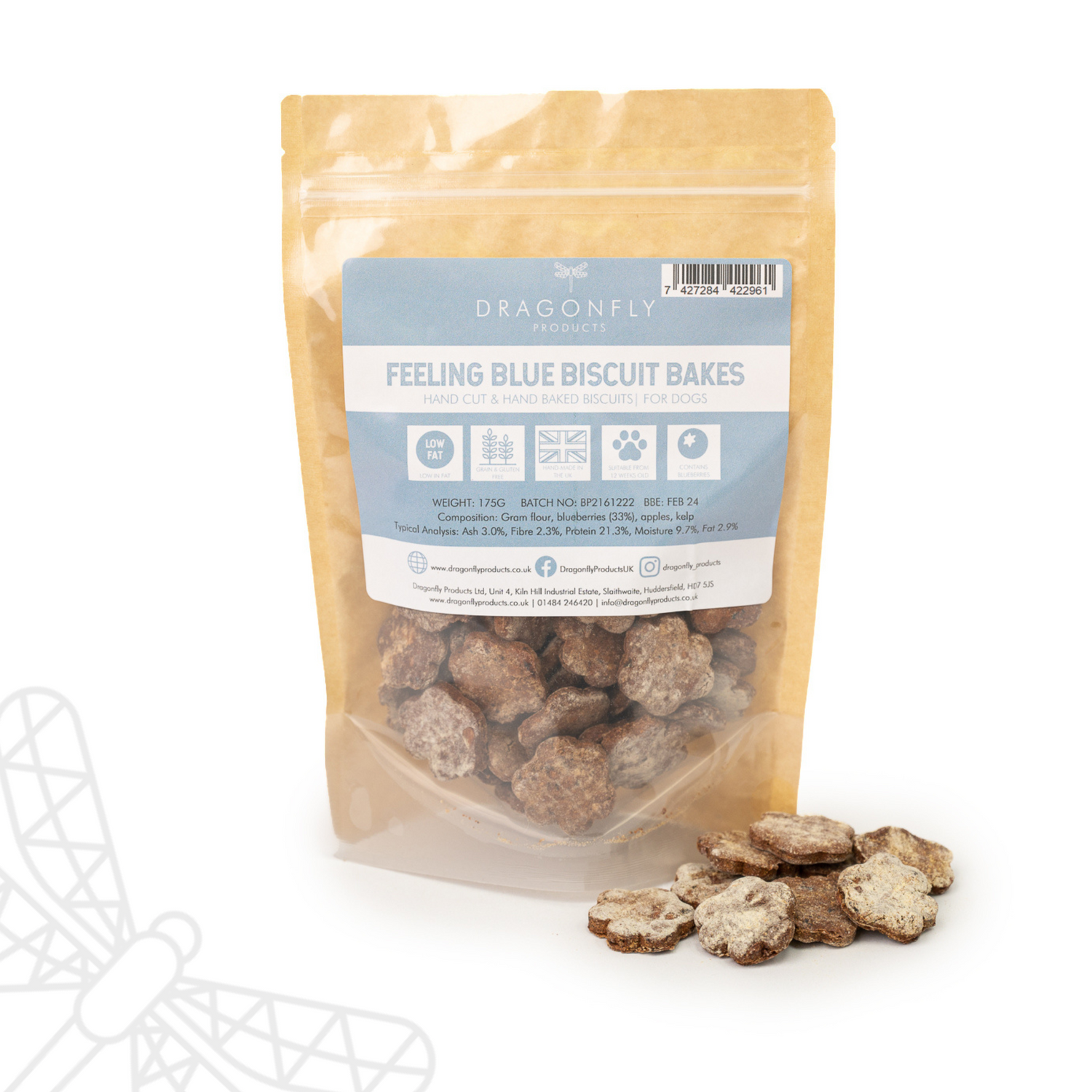
Dog Diarrhoea: Definition, Symptoms, Appearance, Causes and Treatment
Diarrhoea is a common gastrointestinal problem in dogs that is characterised by the frequent passage of smelly loose or watery faeces. It is often accompanied by an increased urgency to poop and can vary in severity, ranging from mild to severe. Diarrhoea can be acute, lasting for a short duration, or chronic, persisting for a prolonged period of time.
Diarrhoea has many different causes ranging from diet to illness. Identifying the cause is important so owners can treat their dog appropriately. The colour and consistency of dog diarrhoea indicates what is causing the digestive upset and what the appropriate treatment is.

What are the symptoms?
There are 7 main symptoms of diarrhoea in dogs. Not every dog will experience all symptoms, and the symptoms depend upon the underlying cause and the severity of the condition.
- Frequent smelly loose or watery stools: Diarrhoea is characterised by the passage of loose or liquid stools with a pungent smell. The consistency and colour of the stool depends on the cause.
- Increased urgency to poop: Dogs with diarrhoea may have a sudden and frequent need to go outside or use their designated bathroom area. They may also strain or have difficulty during bowel movements.
- Accidents in the house: If a dog is experiencing diarrhoea, they may not be able to control their bowel movements, leading to accidents indoors.
- Vomiting: Dogs with diarrhoea may also experience vomiting, especially if the underlying cause affects both the stomach and intestines.
- Lack of appetite: Diarrhoea can cause a loss of appetite or decreased interest in food. However, some dogs may continue to eat normally despite having diarrhoea.
- Lethargy or weakness: If diarrhoea persists or is severe, it can lead to dehydration and electrolyte imbalances, which may result in lethargy, weakness, or decreased activity levels.
- Abdominal discomfort: Dogs with diarrhoea may exhibit signs of abdominal discomfort, such as bloating, abdominal pain, or tenderness.

Appearance: What does dog diarrhoea look like?
The consistency, colour, smell and look of your dog’s diarrhoea point to the underlying problem. Although unpleasant, it is always worth noting changes in case you need to contact your vet.
Consistency
The consistency of diarrhoea in dogs varies depending on the underlying cause and severity of the condition.
Soft stool: Diarrhoea often starts as loose or soft stool that may be unformed but still maintains some shape. It can be similar to pudding or mashed potatoes in consistency.
Watery stool: As diarrhoea progresses, the stool may become more watery and less formed. It can be similar to liquid or runny in consistency.
Mucousy stool: Diarrhoea can also contain mucus, which can give the stool a slimy or gel-like consistency. The presence of mucus can indicate inflammation or irritation in the gastrointestinal tract.
Explosive or projectile diarrhoea: In severe cases, diarrhoea may have a forceful expulsion or be expelled with considerable pressure. This can result in splattering or spraying of the stool.
Blood in the stool: In some cases, diarrhoea may contain blood, which can change its consistency. Blood can give the stool a tarry or dark appearance (melena) or make it visibly red.
Yellow or green diarrhoea
There are 9 main causes of yellow or green diarrhoea in dogs.
- Dietary changes: Abrupt changes in diet or the introduction of new foods can lead to digestive upset and result in yellow or green diarrhoea.
- Scavenging: Dogs may consume inappropriate or spoiled food, rubbish, or substances they shouldn't, which can cause gastrointestinal disturbances and lead to yellow or green diarrhoea.
- Bacterial or viral infections: Infections caused by bacteria, such as Salmonella or Campylobacter, or viruses like parvovirus, can result in yellow or green diarrhoea in dogs.
- Giardia infection: Giardia is a parasitic infection that affects the gastrointestinal tract and commonly causes diarrhoea in dogs. The diarrhoea associated with Giardia infection may be yellow or green in colour.
- Intestinal parasites: Certain intestinal parasites, such as whipworms or certain types of worms, can cause digestive upset and result in diarrhoea, which may be yellow or green.
- Stress or anxiety: Dogs experiencing stress or anxiety, such as during travel, changes in their environment, or separation anxiety, may develop digestive disturbances, including yellow or green diarrhoea.
- Bile-related issues: The presence of bile in the stool can give it a yellow or green colour. If the digestive system is moving too quickly, there may not be enough time for bile to break down fully, resulting in coloured diarrhoea.
- Inflammatory bowel disease (IBD): IBD is a chronic inflammation of the gastrointestinal tract that can cause changes in stool colour and consistency, including yellow or green diarrhoea.
- Medications or toxins: Certain medications or ingested toxins can irritate the digestive system and lead to diarrhoea with a yellow or green appearance.
Black diarrhoea
Black diarrhoea in dogs is known as melena. It is a symptom of bleeding in the upper gastrointestinal tract, although there are also benign reasons for black diarrhoea. Due to this, a dog with black diarrhoea should be evaluated by a veterinarian as soon as possible. There are 7 main causes of black diarrhoea in dogs.
- Consuming rich food: Often seen in raw fed dogs when they have consumed too much offal or rich cuts such as heart
- Gastrointestinal bleeding: The most common cause of black diarrhoea in dogs is bleeding in the upper digestive tract. This can occur due to ulcers, tumours, inflammation, or trauma in the oesophagus, stomach, or small intestine. The blood mixes with the stool as it passes through the digestive system, resulting in black, tarry stool.
- Ingestion of blood: If a dog ingests a significant amount of blood, it can cause the stool to appear black. This can happen if they consume blood from an external source or if they have a nosebleed or bleeding in the mouth.
- Ingestion of certain substances: Some medications, such as iron supplements or certain types of bismuth-containing medications, can cause the stool to turn black. Ingestion of certain substances, like charcoal or black liquorice, can also darken the stool.
- Gastrointestinal parasites: In severe cases of parasitic infestation, particularly with hookworms or whipworms, dogs may experience significant bleeding in their intestines, resulting in black diarrhoea.
- Gastrointestinal tumours: Tumours in the gastrointestinal tract, such as gastrointestinal lymphoma or adenocarcinoma, can lead to bleeding and the presence of black diarrhoea.
- Foreign objects or blockages: If a dog ingests a foreign object that causes a blockage or irritation in the gastrointestinal tract, it can lead to bleeding and black diarrhoea.
Red diarrhoea
Red diarrhoea in dogs is a symptom of bleeding in the lower gastrointestinal tract (that can be confused with streaks of blood in diarrhoea which is commonly caused by inflammation of the colon and is generally harmless). If your dog is experiencing red diarrhoea, it is crucial to seek veterinary attention promptly for an accurate diagnosis and treatment. There are 7 main causes of red diarrhoea in dogs.
- Haemorrhagic gastroenteritis (HGE): HGE is a condition characterised by sudden and severe bloody diarrhoea in dogs. The exact cause of HGE is unknown, but it is believed to involve a combination of factors such as stress, dietary indiscretion, and bacterial or viral infections.
- Inflammatory bowel disease (IBD): IBD is a chronic inflammatory condition that affects the gastrointestinal tract. It can cause irritation and inflammation, leading to bleeding and red-coloured diarrhoea.
- Intestinal parasites: Certain parasites, such as hookworms, whipworms, or coccidia, can cause damage to the intestinal lining, resulting in bleeding and red or bloody diarrhoea.
- Trauma or injury: If a dog has ingested a sharp object or experienced trauma to the digestive system, it can lead to bleeding and red-coloured diarrhoea.
- Infections: Bacterial or viral infections, such as bacterial enteritis or parvovirus, can cause inflammation and damage to the intestinal lining, resulting in bloody diarrhoea.
- Gastrointestinal tumours: Tumours or polyps in the colon or rectum can cause bleeding and result in red-coloured diarrhoea.
- Medications or toxins: Certain medications or toxins can cause gastrointestinal irritation or ulceration, leading to bleeding and red diarrhoea.

How do you treat diarrhoea in dogs?
The treatment of diarrhoea in dogs depends on the length of time, underlying cause and the severity of the condition. Home treatment for mild cases of diarrhoea is recommended but for severe cases, veterinarian treatment should be sought.
- Dietary adjustments: If your dog is just a little under the weather, transitioning to a bland or easily digestible diet can help alleviate diarrhoea. Feeding small portions of steamed sweet potato, boiled chicken or boiled white fish can help to settle your dog’s digestion. Feeding little and often is a great approach until symptoms settle. Avoid feeding your dog rich or fatty foods, as these can exacerbate digestive issues.
- Consult a veterinarian: If your dog is experiencing prolonged or severe diarrhoea, it is advisable to consult a veterinarian for a proper diagnosis and treatment plan. The vet will assess your dog's overall health, consider any underlying conditions or potential causes, and recommend appropriate treatment options.
- Fluid and electrolyte management: Diarrhoea can lead to dehydration and electrolyte imbalances in dogs. Kefir and bone broth are a great way to get fluids into your dog along with good bacteria for the gut. You can make bone broth at home or buy ready made bone broth. Your veterinarian may provide electrolyte solutions if required to help restore hydration and balance. In severe cases, fluid therapy may be administered intravenously.
- Treat underlying causes: If the diarrhoea is caused by an underlying condition, such as parasites, bacterial infections, or inflammatory bowel disease, your veterinarian will develop a treatment plan specifically tailored to address the underlying cause. This may involve deworming medications, antibiotics, anti-inflammatory drugs, or other appropriate therapies.
- Follow-up care: It's important to monitor your dog's progress. If the diarrhoea persists or worsens, or if your dog shows other concerning symptoms, contact your vet for further guidance.
- Supportive care: Along with the suggestions above, providing a calm and stress-free environment for your dog can help in the recovery process. Make sure your dog has access to clean water, a comfortable resting area, and regular bathroom breaks.
Diarrhoea and poor quality dry dog food
The link between poor quality dog food and diarrhoea in dogs is significant and the most common cause of recurrent diarrhoea. Dogs are carnivorous animals with specific dietary requirements, and their digestive systems are not designed to handle certain ingredients commonly found in low-quality dog food. Poor quality dog food often contains a high proportion of fillers, artificial additives, and low-grade ingredients that can be difficult for dogs to digest.
The most common issue with low-quality, cheaper dry dog food is the presence of excessive amounts of grains and carbohydrates. While dogs can tolerate some carbohydrates in their diet, an excessive intake leads to digestive problems. Dogs lack the necessary enzymes to efficiently break down complex carbohydrates, leading to fermentation in the gut. This fermentation process causes an imbalance in the gut bacteria and result in diarrhoea.
Additionally, low-quality dry dog food may contain artificial preservatives, colourings, flavour enhancers, and additives that irritates a dog's digestive system. These additives cause an adverse reaction in sensitive dogs, leading to diarrhoea as a symptom.
Switching a dog to a high-quality dry dog food with a high meat content will significantly help prevent bouts of diarrhoea. Dogs are carnivores by nature, and their digestive systems are adapted to thrive on a diet rich in animal protein.
Dry dog food manufacturers should prioritise freshly prepared or dried meat as the primary ingredient, to provide dogs with the essential nutrients they need for optimal digestion and overall health.
A diet with a high meat content ensures that dogs receive an adequate amount of easily digestible protein. This protein is essential for supporting healthy digestion, as it provides the necessary building blocks for maintaining strong muscles, organs, and enzymes involved in the digestive process.
For any further help and advice please contact us on 01484 246420 and why not join our social media channels and online community on Instagram, Facebook or YouTube.
With Wags and Woofs,
Laura, Dolly & Reggie


